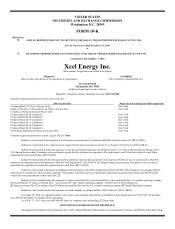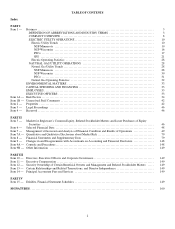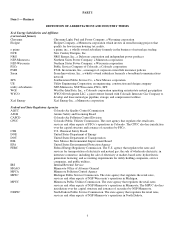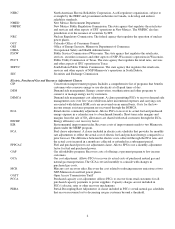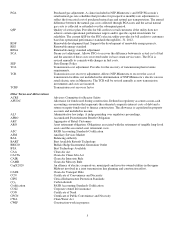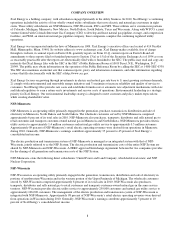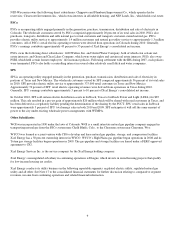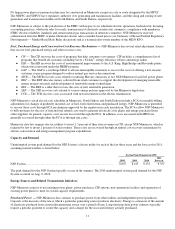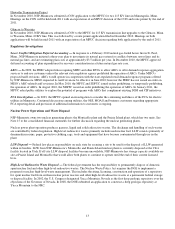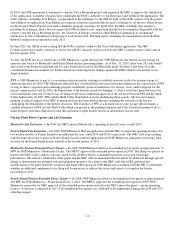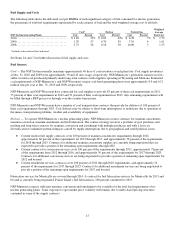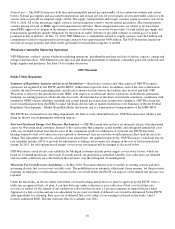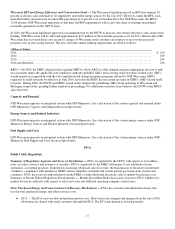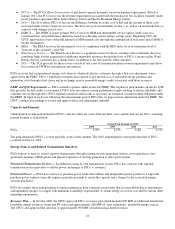Xcel Energy 2010 Annual Report Download - page 21
Download and view the complete annual report
Please find page 21 of the 2010 Xcel Energy annual report below. You can navigate through the pages in the report by either clicking on the pages listed below, or by using the keyword search tool below to find specific information within the annual report.
11
No large power plant or transmission line may be constructed in Minnesota except on a site or route designated by the MPUC.
The NDPSC and SDPUC have regulatory authority over generating and transmission facilities, and the siting and routing of new
generation and transmission facilities in North Dakota and South Dakota, respectively.
NSP-Minnesota is subject to the jurisdiction of the FERC with respect to its wholesale electric operations, hydroelectric licensing,
accounting practices, wholesale sales for resale, transmission of electricity in interstate commerce, compliance with mandatory
NERC electric reliability standards and certain natural gas transactions in interstate commerce. NSP-Minnesota received
authorization from the FERC to make wholesale electric sales at market-based prices (see Summary of Recent Federal Regulatory
Developments — Market-Based Rate Rules discussion) and is a transmission-owner member of the MISO RTO.
Fuel, Purchased Energy and Conservation Cost-Recovery Mechanisms — NSP-Minnesota has several retail adjustment clauses
that recover fuel, purchased energy and other resource costs:
● CIP — The CIP recovers the costs of programs that help customers save energy. CIP includes a comprehensive list of
programs that benefit all customers including Saver’s Switch®, energy efficiency rebates and energy audits.
● EIR — The EIR recovers the costs of environmental improvements to the A.S. King, High Bridge and Riverside plants,
which were renovated under the MERP program.
● GAP — The GAP is a surcharge billed to all non-interruptible customers to recover the costs of offering a low-income
customer co-pay program designed to reduce natural gas service disconnections.
● MCR — The MCR recovers costs related to reducing Mercury emissions at two NSP-Minnesota fossil fuel power plants.
● RDF — The RDF allocates money collected from retail customers to support the development of emerging renewable
energy projects research and development of renewable energy technologies.
● RES — The RES is a rider that recovers the costs of new renewable generation.
● SEP — The SEP recovers costs related to various energy policies approved by the Minnesota legislature.
● TCR — The TCR recovers costs associated with new investments in the electric transmission.
NSP-Minnesota’s retail electric rate schedules in Minnesota, North Dakota and South Dakota include a FCA for monthly billing
adjustments for changes in prudently incurred cost of fuel, fuel related items and purchased energy. NSP-Minnesota is permitted
to recover these costs through FCA mechanisms approved by the regulators in each jurisdiction. The FCAs allow NSP-Minnesota
to bill customers for the cost of fuel and fuel related costs used to generate electricity at its plants and energy purchased from
other suppliers. In general, capacity costs are not recovered through the FCA. In addition, costs associated with MISO are
generally recovered through either the FCA or through rate cases.
Minnesota state law requires electric utilities to invest 1.5 percent of their state revenues in CIP, except NSP-Minnesota, which is
required by law to invest 2 percent of state revenues. These costs are recovered through an annual cost-recovery mechanism for
electric conservation and energy management program expenditures.
Capacity and Demand
Uninterrupted system peak demand for the NSP System’s electric utility for each of the last three years and the forecast for 2011,
assuming normal weather, is listed below.
System Peak Demand (in MW)
2008 2009 2010 2011
Forecast
N
SP Syste
m
..................................................................... 8,697 8,615 9,131 9,357
The peak demand for the NSP System typically occurs in the summer. The 2010 uninterrupted system peak demand for the NSP
System occurred on Aug. 9, 2010.
Energy Sources and Related Transmission Initiatives
NSP-Minnesota expects to use existing power plants, power purchases, CIP options, new generation facilities and expansion of
existing power plants to meet its system capacity requirements.
Purchased Power — NSP-Minnesota has contracts to purchase power from other utilities and independent power producers.
Capacity is the measure of the rate at which a particular generating source produces electricity. Energy is a measure of the amount
of electricity produced from a particular generating source over a period of time. Long-term purchase power contracts typically
require a periodic payment to secure the capacity and a charge for the associated energy actually purchased.


